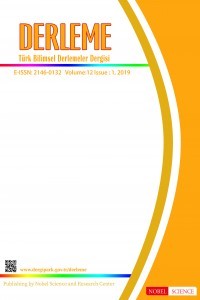Safran (Crocus sativus L.)’ın Farklı Eksplantlarından In vitro Koşullarda Bitki
Çoğaltımı Hakkında Derleme ve Beklentiler
Safran dünyanın en pahalı baharatı, bir sonbahar-çiçek açan, triploid erkek-kısır ve vegetativ olarak çoğaltılan bir bitkidir. Düşük çoğaltma oranı ve fungal bulaşmasından verimlilik ve kalite düşer dolaysıyla, bitki materyalı sınırlamaktadır. Bu yüzden, organogensis ve kormogensis metotlarla safranın mikroçoğaltımı, bitkinin büyük ölçekli üretim, hastalıksız soğanlar üretimi için aktraktif bir araçtır. Ayrıca, safranın sekonder maddelerin biyokimyasal sentezinin öğrenmesine yönünde kolaylık sağlar. Bitkinin üreme yeteneği genotip, explant, kültür başlatma süresi ve kültür ortamının bileşenlerine bağlıdır. Oksin tipi hormonların bitki ortamın substratının düzenlemesine ve bunun aksine düşük miktarda sitokininler ters etkilelere neden olmaları belirmektedir. Buna ek olarak, özellikle zeatin ve 2,4-D ile katılaşmış ortam sürgün oluşumu için in vitro koşullarında gereklidir. Uç meristemlerin etilen ve etafon, ardından mikrocerrahi ile muamelesi, sırasıyla kormogenic nodüller ve soğanların üremesini arttırmıştır. Bunun yanında, etilen ve etafon ile ön uygulamalar soğan üretimini arttırırken yaprak oluşumunu engellemiştir. Tohumluk eksplantlardan elde edilen harici sürgünler denemelerinde NAA ve BA ile tamamlanan MS ortamı, bir tohumluk için en yüksek oluşan sürgün sayısını sağladı. Genel olarak, en iyi sürgün gelişmesi, yaprak sayı ve uzunluğu açısından 0.54 µM NAA ve 2.22 µM BA ortamından elde edilmiştir. Denenen segmentlerin olgunlaşma ve çimlenme aşamalarının optimizasyonu yönünde tamamlayıcı çalışmalar yapılmaktadır.
Enhanced Plantlet Induction from Cultıured Segments of Saffron (Crocus sativus L.) through In vitro Micropropagation: Background and Prospects
Saffron, the costliest spice of the world, is an autumn-flowering, triploid male-sterile plant propagated vegetatively by means of corms. Low multiplication rates and fungal infestation of corms reduce the productivity and quality, thereby restraining the availability of planting material. Hence, in vitro propagation through organogensis and\or cormogensis is an attractive means of large-scale production of disease-free cormlets and also a tool to facilitate a better understanding of the bio-chemical synthesis of Saffron secondry products as well. Proliferation ability is dependant on genotype, explants, culture initiation time and copmisition of the culture medium. It has been found that a high level of auxin-type growth regulating substances favored cell cultures of the crop, while low levels of cytokinin may have diverse effects. Moreover, the medium solidified with cytokinins, particularly zeatin and the auxin 2,4-D are essential for regular bud in vitro development. Microsurgery of apical buds followed by ethylene or ethaphon treatment increased the cormogenic nodules and corm production, respectively. On the other hand, ethylen and ethaphon pretreatments, though affecting corm production positively, inhibit leaf development. In the studies of direct adventitious shoot regeneration from ovary explants, full strenght MS medium supplemented with NAA and BA produced the best response towards callogenesis with highest shoot number per ovary. on the whole, the idealist induction toward shoot growth both in terms of leaf lenght and number, is on the medium with 0.54 µM NAA and 2.22 µM BA. Complementary studies are in progress to optimizematuration and germination stages of mentioned segments
